An air lock has formed - in this case, how can you bleed the air from the heating radiator?

The air is excellent heat insulator. This makes it unsuitable as a heat carrier in closed heating systems.
If air gets into the radiators, it reduces their effectiveness, and also can partially block the flow of water in pipes.
To ensure that the heating system operates normally, it is best to remove air from the radiators. This operation is called "deflation" of batteries.
Content
- How to find an airlock in general and individual heating systems
- How to bleed air from a radiator
- How to fill a gravity system with water
- New filling of the closed type system
- If there is no valve: how to bleed a “dead” battery
- What can happen if you do not bleed the air in time?
- Useful video
- How often to bleed radiators in a private house
How to find an airlock in general and individual heating systems
During start-up work, when preparing the heating for winter or during operation, the following signs of air can be observed:
- gurgling coolant in pipes;
- cold top batteries;
- part of the system does not work;
- high resistance the flow of water in the pipes.
Where does air come from in the system:
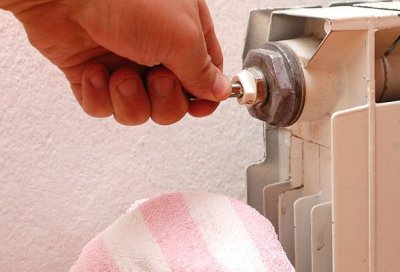
- Not completely removed when filling systems.
- Release of air from the coolant during heating.
- Airing at repair.
- Gradual air penetration through plastic pipes.
It is quite easy to identify an airlock: an area filled with air significantly colder. The percussion method is also used: a tube filled with liquid sounds different when struck than when filled with air.
Air always accumulates in "pocket" - a high point. The most difficult are considered to be airlocks in warm floors: it is not always possible to maintain an ideal horizontal level, the accumulated air accumulates at the top of the pipe, and circulation continues at the bottom. It is almost impossible to expel such a plug - pressure testing will be required.
How to bleed air from a radiator
In closed systems, instead of an expansion tank, a pressure tank is installed at the top connection point. ball valve or automatic air bleeder, through which air is released.
As the system fills, air must be removed from the bottom up. All "air pockets" - batteries, pipe loops - must be equipped with air release devices.
Mayevsky crane
The most popular way to remove air from a battery is to install it at its highest point. air release valve. The Mayevsky tap consists of a brass body and a small threaded nipple. If the nipple is unscrewed, the battery will be depressurized. The contents will flow out through a small hole in the body.
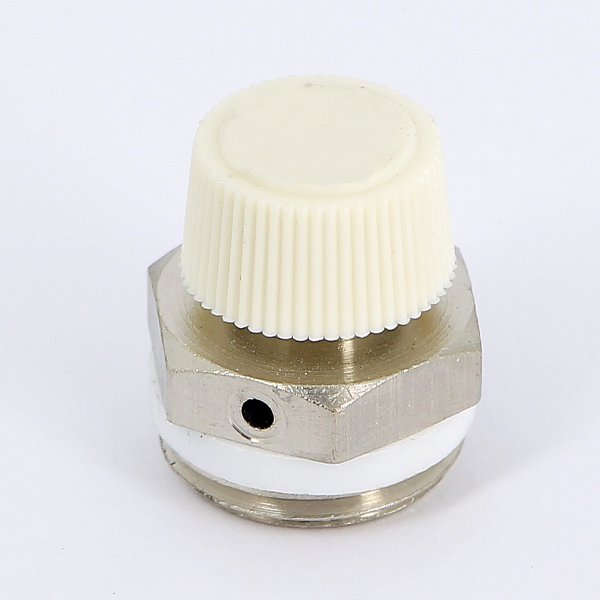
Photo 1. Manual air vent, or Mayevsky valve, model 194 1/8', manufacturer - "Itap", Italy.
To service the radiator, you will need a container for water, a faucet key or a screwdriver, a rag to remove splashes.
We place a container under the Mayevsky tap and unscrew the nipple with the other hand. It has a square cross-section - a special key or pliers are required.
We wait until the air is released and 10-200 milliliters of liquid.
We turn off the tap and move on to the next battery.
It is necessary to bleed air in order, starting from return linesThe pressure from the return line removes air very well, so the filling valve is usually designed closer to the lowest point near the boiler.
Automatic air vent
For a large system that is filled and drained each season, it is appropriate to use automatic gas valves. They look like a small barrel, installed on a section of pipe strictly vertically.
Important! The automatic valve is installed in the top point of the "air pocket", and serves for self-adjustment of heating. Installing the valve only in the boiler can lead to air in the system.
The valve consists of body and float. If there is air in the system, the float does not rise, and the gas comes out calmly. As soon as the water rises, the float closes the hole - the water does not come out. The gas accumulated at the top point squeezes out the water, the float falls again, releasing the gas until the water appears.
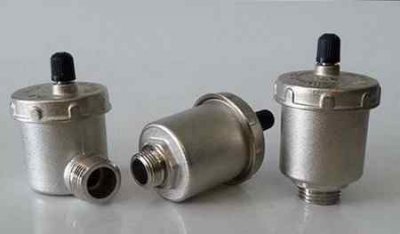
The automatic air vent is very demanding regarding the cleanliness of the coolant: scale, rust and dirt may clog the float chamber. Liquid will pass through the valve or it will not release air on its own.
Use purified water, it is necessary to filter the coolant before filling. The heating system is periodically flushed and mud filters are checked.
Air separator
To collect thousands of tiny air bubbles and push them out of the heating, air separators are used. They are installed in an easily accessible place, closer to the return inlet to the boiler. The device looks like a truncated cone with the apex at the top.
Inside the cone is special stuffing in the form of rings or metal shavings. Air bubbles settling on the surface are squeezed out by the water flow to the top of the cone, where they accumulate and are thrown out.
The separator is also used for cleaning from scale and sludge. For this purpose, there is a removable sump at the bottom. For easy cleaning and maintenance during installation, it is worth providing two ball valves on both sides from the pipe.
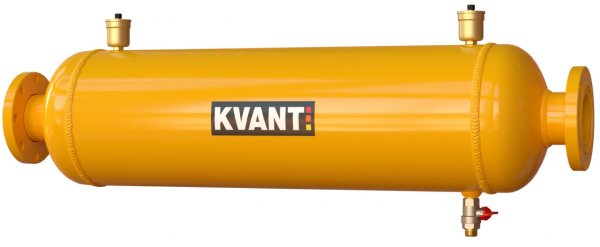
Photo 2. DisAir horizontal air separator, HF-Q series, carbon steel body, manufacturer - "Kvant", Ukraine.
The separator does not require special maintenance and operates automatically. Once a year, before the start of the heating season, the packing is checked for cleanliness, and accumulated dirt is removed from the sump.
How to fill a gravity system with water
The peculiarity of the gravity system is its relative simplicity. All pipes and batteries are installed with slopes. The expectation is that the water will circulate through the system itself. Air is removed along with the liquid and enters the expansion tank.
Some amount may remain if the system is branched or slopes are not observed, but these residues are easily removed using Mayevsky crane, installed in batteries. Filling usually starts from the lowest point: the return line near the boiler.
New filling of the closed type system
The peculiarity of closed systems is the absence of direct contact with the atmosphere. Air in such systems has to be released manually through air release valves.
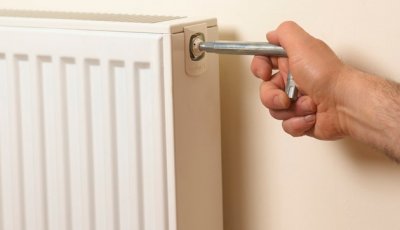
Cranes in such a system are located at several points: at the highest point of the system above the boiler or on the top floor, in the boiler itself, on the batteries.
When filling, a transparent hose is placed on the top tap, and the coolant is pumped until clean water comes out of the hose.
The tap closes, membrane expansion tank Air is pumped in to create pressure and the batteries are de-aerated.
When installed in the system circulation pump, it will successfully drive out the remaining air. If after some time gurgling sounds are heard in the boiler or radiators, it is worth repeating the operations with the taps.
If there is no valve: how to bleed a “dead” battery
In old heating systems with cast iron radiators, Mayevsky taps were not provided, air bleeding was carried out by gravity or by unscrewing the plug radiator.
To bleed the battery, you will need:
- Adjustable plumbing wrench.
- Basin.
- Rags.
We clean the upper end of the battery from paint, put a rag soaked in penetrating lubricant on the joint (WD-40, kerosene, brake fluid). After a few hours we try to unscrew the plug.
Reference! The thread can be either left or right! Please attach alternately efforts now one way, now the other alternately. Watch which direction the plug starts to move away from the battery.
As soon as you hear air movement, stop unscrewing the plug.
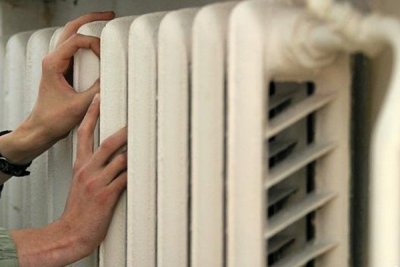
We put a basin under it and cover the cork with rags — splashes of coolant will inevitably break through along with the air.
As soon as the hissing stops, we wind it under the cork tow or fum tape and wrap it back in place.
If possible, to facilitate repeated bleeding, replace the blind plug with the same one, only with a Mayevsky tap installed. To do this, you will have to isolate the battery from the heating, drain the water from it.
Important! Under no circumstances should you attempt to replace the battery cap. under pressure - the flow of hot water will not allow the thread to be tightened.
In a private home, air bleeding should always be accompanied by control of the amount of coolant, and if it is not enough, top it up. In open expansion tanks there should be at least half of the tank of liquid, in closed ones - pumped pressure up to 2 atmospheres.
What can happen if you do not bleed the air in time?
Oxygen - promotes corrosion of pipes and batteries. It has a negative effect on the operation of the impeller of forced circulation pumps.The murmur of air in the radiators does not add to the silence and comfort in the house.
Accumulations of gases can completely block an entire section of the heating system.
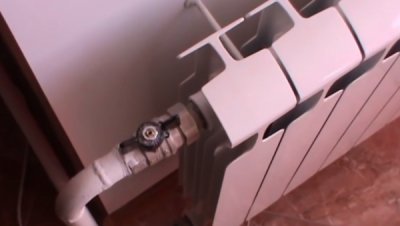
Air accumulates not in one day — water degassing is a long process, lasting in a few years.
After this period, the system is filled with “dead” water, which does not support oxidation and sludge formation.
The use of glycol antifreeze compounds is not always acceptable - in combination, for example, with zinc, it leads to oxidation and sludge formation, clogging of pipelines and heat exchangers.
It is not difficult to bleed new batteries yourself, they usually have thermostats and Mayevsky taps installed. When they are not there, it is better to ask for help from to a professional plumber - he has enough knowledge and tools to avoid turning your home into a hot lake.
Useful video
Watch the video to learn how to properly bleed a radiator.
How often to bleed radiators in a private house
It is necessary to remove accumulated gases before the start of each heating season. If water is used as a heat carrier, do not rush to change it often. Fresh liquid will contain a large amount of dissolved oxygen, which later settles in the form of bubbles on the walls of the batteries and boiler. Over time, gas particles "leave" the water, and air bleeding will be required less and less often.
At the first test run, it is necessary It is worth checking the system for cold spots, and it is necessary to carry out routine maintenance.






